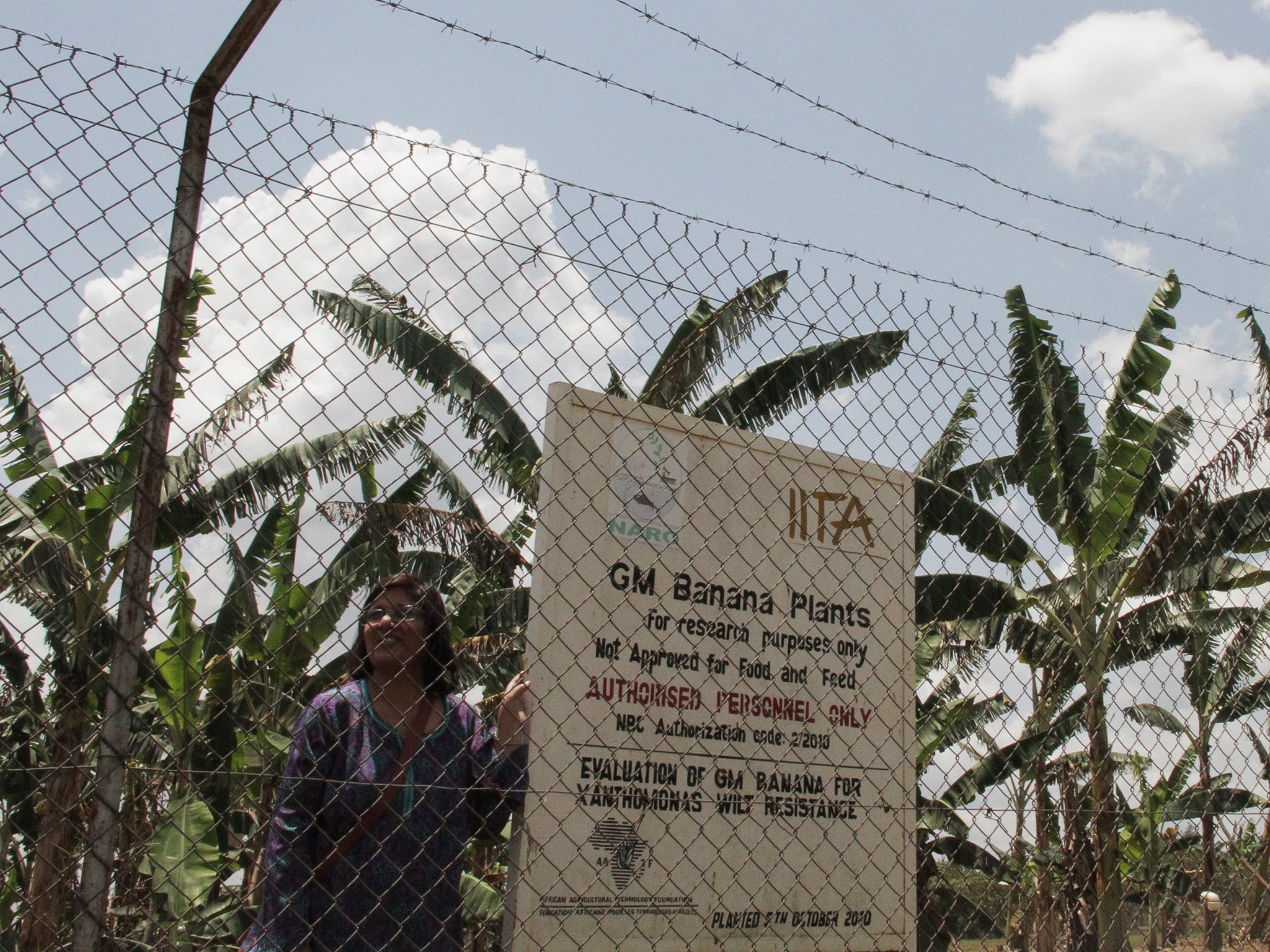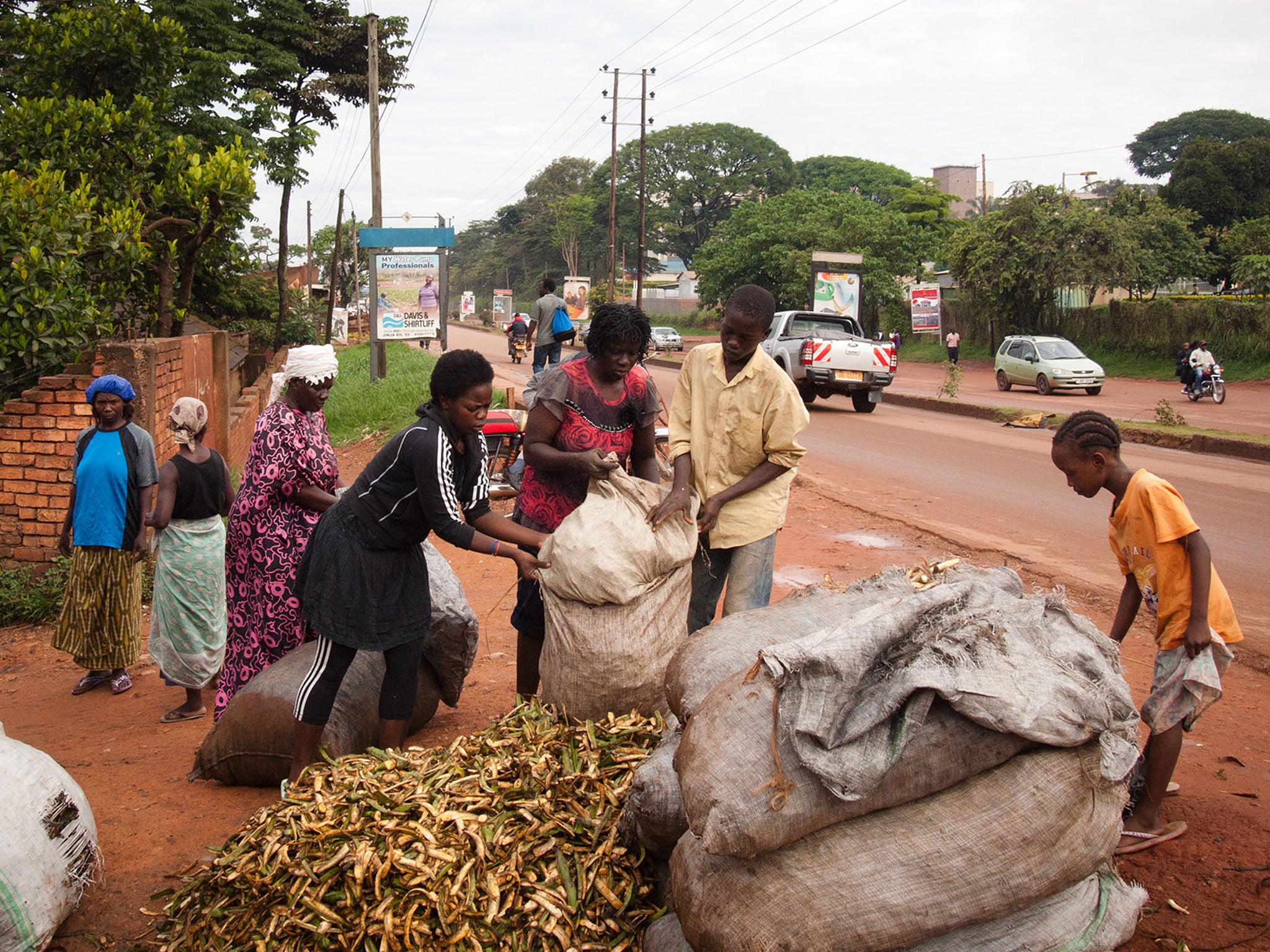The GM crops debate moves to Africa – and it’s just as noisy
Oliver Wright reports from Uganda on a project involving a staple food crop – the matooke – which has sparked frantic political lobbying

It is strange to see an apparently ordinary field surrounded by a seven-foot steel fence topped with barbed wire. The banana trees being grown inside don’t look any different from those that are ubiquitous in the surrounding African countryside. The only thing that marks them apart is the fence, two security guards in smart green-and-black uniforms, and little white markers at the foot of each plant, each with a unique but unintelligible code.
But this field, six miles from the Ugandan capital Kampala, is the new front line in the great genetically modified (GM) food battle that has moved from the developed world to the developing world – with no less ferocity.
The same groups that have fought over GM in Europe for nearly two decades are now campaigning in countries like Uganda to stop the technology from spreading to Africa.
And what happens here will help determine whether GM becomes accepted in the developing world – nearly 20 years after the first crops were planted in the West.
At the forefront of this battle is a dispute over a specific GM project – supported by the Bill and Melinda Gates Foundation – to create a modified version of the country’s staple food crop, the matooke, a starchy variety of banana, that cannot be killed off by a disease called banana leaf wilt that has been devastating plantations.
Within the next few years the scientists working on the project hope to have a plant that has proven resistance to the wilt – by inserting a gene found in red peppers.

The plants behind barbed wire in the fields at the National Agricultural Research Institute are being grown to see if the technology will work. But even if it does, at the moment the law allows these plants to be grown only under heavily regulated conditions – hence the fences and the guards to prevent them from entering the wild.
And despite its philanthropic nature, the project is being ferociously resisted by a wide range of local civil society groups and a few NGOs.
Some of them argue that the technology is still not proven to be safe, while others say it is unnecessary because other methods are available to combat banana leaf wilt. They argue that GM is being used by big multinationals as a “charitable” Trojan horse to enter the continent’s expanding agricultural market.
They are fighting to prevent the Ugandan parliament from passing a law that would allow the fences to come down and for the crop to be made freely available for farmers to grow.
A bill setting out a potential regulatory framework for GM crops is likely to go before the parliament in the next few months, and both sides are actively lobbying legislators.
For the pro-GM campaigners, this involves inviting groups of MPs out to places such as the Agricultural Research Institute to talk to the scientists who do the work. Some MPs have been so impressed that they’ve asked for some plants to take away for themselves – despite the fact that removing them would be illegal.
The anti-GMs have concentrated their campaigns on using the public to pressure MPs not to go along with the pro-GMs. They have organised meetings in their constituencies and hope people power will win out.
A few MPs clearly don’t know what to think. “There was an MP who came to the labs and said ‘this is brilliant – what is government waiting for?’” said Arthur Makara from the Science Foundation for Livelihoods and Development. “Then the following week a Catholic charity organised a workshop in his constituency and brought the bishop along. They managed to convince this guy and he’s now strongly opposed to biotech and GM.”

Bridget Mugambe, from the Alliance for Food Sovereignty in Africa, said biotechnology was the “wrong solution” to the “right problem”.
“Not all the bananas are affected by wilt and there are farmer solutions to the problem,” she said. “There are solutions among the farmers that are not being exploited because there is already this perceived technological solution to the problem.
“I see the banana as an entry point for other GMOs [genetically modified organisms] that are intended to make money – like cotton. But they need an entry and they feel the banana is that kind of entry.”
Ms Mugambe is also suspicious of the involvement of charities who she believes may “put money where their interest is”. She is concerned that “they put money into something where they expect to reap some kind of profit”.
This is rejected by the scientists at the banana project, who insist that they have no interest in big agriculture but are trying use the technology to solve problems that are specific to Uganda.
Charles Changa, a Ugandan plant scientist who is among those heading up the work, said it had the potential to eradicate bacterial wilt and could be used to tackle other plant diseases that also reduce yield, push up prices and contribute to food insecurity.
“What Uganda needs is a product that is safe and works, and once you have it ready then it will be the catalyst. The eyes of the Africans are in their hands. When the Ugandan public can touch and feel the banana they will love it.”
Leena Tripathi, another of those involved the project, said: “I am a scientist. It’s 19 years since these crops were commercialised and there has not been even a single report in a peer-reviewed journal that shows a negative impact – either on human health or anything else. We’re still doing food safety studies on our trial but we would never release a product that was not safe.”
Setting aside safety, opponents argue that GM technology would lead to the intensification of farming in Africa – damaging the livelihoods of small farmers and the country’s growing organic industry. They also believe that once philanthropic projects are given the go-ahead, they will be followed by big companies like Monsanto – eager to seize control of African fields. “The issue of GM is very controversial and these guys have not come up and clearly explained the advantages of GMOs,” said Ellady Muyambi, another anti-GM campaigner. “We are saying, ‘Tell us who are the beneficiaries of this technology? Are they the multinational companies or the local farmers?’
“We are looking at a scenario where these people are engineering crops and we will very soon lose that ownership [of the seeds].”
Fredrick Kawooya, the policy and campaigns manager at ActionAid Uganda, agreed: “We have this suspicion that we are surrendering our sovereignty over the food system to the corporates in the long run. The corporates that are interested in this have managed to secure control over the policy-making bodies, over most of the philanthropic donors, of the research institutions and all this. [But in Uganda] agriculture is not just for money. It is beyond that.”
This is rejected by Frank Shotkoski, a scientist who used to work for the multi-national biotech firm Syngenta but who now runs philanthropic GM programmes in Uganda, Bangladesh and the Philippines.“We need to dispel this myth that multinationals are trying to control the food supply in developing countries,” he said. “The work we do is public. We put the technology in open pollinated plants so that the farmers can save their seed, do their own crosses. There isn’t going to be a tech fee or royalty associated with it. It’s being developed by public institutions for the public good.”
But is it, as some claim, a Trojan horse for other more commercial crops?
“That’s a myth,” he said. “The companies are too busy to deal with this kind of thing. They’re after the bottom line – which they only get from huge acreages that just don’t exist in countries like Uganda.”
Sir Gordon Conway, professor of international development at Imperial College London, said it was important for pro-GM campaigners not to overstate their case, but it could be useful for some intractable problems.
“Sub-Saharan Africa will achieve food security over the next couple of decades, primarily through conventional means,” he said. “[But] Africa’s farmers have to cope with horrendous pest and disease problems, far, far worse than any we know in the UK. This is where GM has a role.”
Developing resistance: The banana programme
The process of creating a genetically modified crop is seemingly simple but fiendishly complicated, unpredictable and lengthy.
In the case of the savoury Nakitembe banana – the staple food crop in Uganda and other parts of eastern Africa – it begins with its flower.
Looking through a microscope, lab technicians tease out the tiny reproductive cells which will ultimately become new GM plants. The cells are placed in petri dishes and moved to the ‘transformation room’. They are fused with genes from other plants (in this case the sweet pepper) that will ultimately give them their resistance to diseases and pests estimated to cost the Ugandan economy $360m a year.
The cells are fused with the new DNA using a bacterium that in the wild causes a disease known as plant cancer to create the beginnings of a new plant that, to all intents and purposes, is the same Nakitembe banana but with the resistance to wilt of the red pepper.
The Banana programme began in earnest in 2007 – but even with regulatory approval those running the programme say it will be 2020 before they have a product ready to go to market.
Join our commenting forum
Join thought-provoking conversations, follow other Independent readers and see their replies
Comments